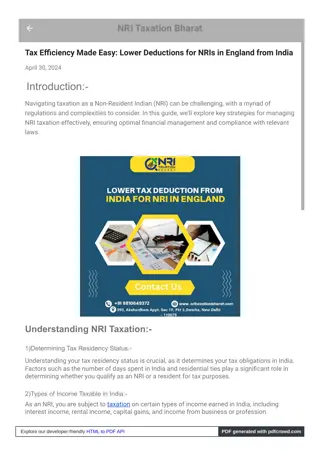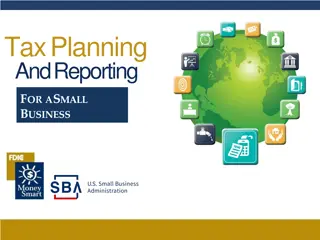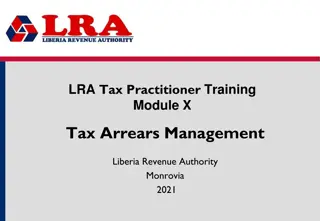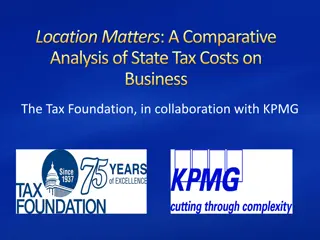
Tax Planning Strategies: Paying Smartly to Achieve Goals
Explore tax planning to optimize your financial goals by understanding federal tax processes, major tax features, and legal strategies to minimize taxes. Dive into a case study showcasing tax calculations and recommendations.
Download Presentation

Please find below an Image/Link to download the presentation.
The content on the website is provided AS IS for your information and personal use only. It may not be sold, licensed, or shared on other websites without obtaining consent from the author. If you encounter any issues during the download, it is possible that the publisher has removed the file from their server.
You are allowed to download the files provided on this website for personal or commercial use, subject to the condition that they are used lawfully. All files are the property of their respective owners.
The content on the website is provided AS IS for your information and personal use only. It may not be sold, licensed, or shared on other websites without obtaining consent from the author.
E N D
Presentation Transcript
Personal Finance: Another Perspective Tax Planning: Paying All You Owe and Not a Penny More Updated 2019-09-17 1 1
Objectives A. Understand how tax planning and can help you attain your personal goals and the principles of tax planning B. Understand the Federal tax process C. Understand the major tax features of our tax system and tax strategies to help lower your taxes (legally and honestly) D. Understand and create your Tax Plan 2 2
Your Personal Financial Plan Section V.: Taxes What is your vision and goals for your taxes? (use Tax Template LT01-05) What Tax Form and Tax Strategies did you use last year? What was your marginal and average tax rates? What are your Plans and Strategies for the future? What else can and should you do to reduce your tax bill to Uncle Sam? What are your constraints and accountability? Note: Federal Tax Worksheet (LT39) may be helpful 3 3
Case Study Data: Matt and Janina, ages 42 and 40, are married and filling out their taxes. They have 4 children, 3 under 17 and one a dependent in college. They contributed $5,000 to a traditional 401k in 2019, $2,500 to a flexible spending plan, and state and local taxes were $11,000. They can only deduct medical bills above 10% of AGI and state taxes <= $10,000. The standard deduction for married filing jointly is $24,400, and the child tax credit is $2,000 per child under 18. Tax rates for 2019 for married filing jointly are: $0 to $19,400 10% $19,400 to $78,950 $1,940 plus 12% of the amount over $19,400 $ 78,950 to $168,400 $9,086 plus 22% of the amount over $78,950 Income:Earned Income Interest Income Expenses:Home mortgage interest Un-reimbursed medical bills Tithes and offerings Calculations: Using the married filing jointly status and the information above, calculate their 2019 taxes first using the standard deduction and then using itemized deductions. Calculate their marginal tax rate and average tax rate on gross income. Recommendations: Which way should they calculate their taxes? What could they do to reduce their taxes? $80,000 10,000 6,800 9,063 9,600 4 4
A. Understand How Tax Planning can help Attain your Goals and Principles of Tax Planning Why tax planning? Taxes are your largest single annual expense The average American works more than 4 months just to pay his or her taxes In sum, the less you pay Uncle Sam (for a given level of income), the more you have for your personal and financial goals! Is there any area of your life that taxes do not impact? 5 5
Tax Freedom Day 1900-2019 6 6 Source: Tax Foundation, Washington, D.C., https://taxfoundation.org/tax-freedom-day-2019, Sept. 17, 2019.
Tax Planning (continued) The Lord has said: Let no man break the laws of the land, for he that keepeth the laws of God hath no need to break the laws of the land. Wherefore, be subject to the powers that be, until he reigns whose right it is to reign, and subdues all enemies under his feet (D&C 58:21-22). Harold B. Lee said: There seem to be those among us who are as wolves among the flock, trying to lead some who are weak and unwary, . . . who are taking the law into their own hands by refusing to pay their income tax. (Ensign, January 1973, p. 106.) 7 7
Tax Planning (continued) What are the principles of tax management 1. Know yourself, your goals, vision, and values 2. Seek, receive and act on the Spirit s guidance 3. Keep good records for tax and other purposes 4. Understand the tax system so you can make wise decisions regarding your finances 5. Get good help if needed to make better decisions 6. Pay everything you owe for taxes, and not a penny more 8 8
Tax Planning (continued) Principles Doctrines Know yourself, your vision and goals Identity Seek, receive and act on guidance Obedience Keep good records Stewardship Understand the tax system Accountability Get good help if needed Stewardship Pay everything you owe Agency 9 9
Tax Planning (continued) From Obedience to Consecration I am a child of Heavenly parents (identity), trying to live worthy of the Spirit (obedience), who is learning important information about the tax system (accountability), wisely keeping records of my income and expenses (stewardship), and getting good help when needed (stewardship). I act with integrity to minimize my tax payments to the government (agency), so that I can have sufficient assets to accomplish my personal mission and to accomplish the things that Heavenly Father and I and my family would have me accomplish. 10 10
Tax Planning (continued) Any questions on the importance and principles and doctrines of tax planning? 11 11
B. Understand the Federal Tax Process 3. Subtract the greater of Standard or Itemized Deductions to get Taxable Income 5. Minus Credits = Total Tax Owed 1. Start with Income from All Sources less Exclusions and Deferrals = Total Income 2. Subtract Adjustments to Gross Income (for AGI deductions) = Adjusted Gross Income (AGI) 4. Look up tax on tax table (tax = taxable income times tax rate) = Tentative Tax 6. Minus Taxes already Paid = Balance Due or Amount of Refund 12
Definitions 1. Total Income Total or gross income for tax purposes is all income, unless specifically excluded or deferred Exclusions include certain employer provided fringe benefits and contributions, contributions to qualified retirement accounts (401k, 403b, 457 plans, etc.) that are not Roths, gifts and inheritances, life insurance proceeds, grants not in excess of college expenses, municipal bond interest, and interest for education savings vehicles used for education Deferrals include like-kind exchanges 13 13
Definitions(continued) 2. Subtract Adjustments to get AGI Adjustments are deductions from total income allowed by the IRS to get your Adjusted Gross Income (AGI): Qualified medical (flexible) savings contributions Contributions to non-Roth Individual Retirement Accounts and Health Savings Accounts (IRAs/HSAs) Student loan interest/tuition/fees deduction (IRS 970) One-half self employment tax, and losses including net capital losses (up to $3,000), sole proprietorship losses, and active participation real estate losses 14 14
Definitions(continued) 3. Subtract Greater or Standard Or Itemized Deduction Deductions are IRS allowed amounts (standard deduction) or taxpayer determined amounts (itemized deductions) to get taxable income from your AGI Year Standard Deduction $ (MFJ) 2017 2018 24,000 2019 12,700 24,400 15 15
Definitions(continued) Itemized Deductions Allowable deductions (if you itemize) include: Charitable contributions (cash, in kind, mileage) Home mortgage interest Medical expenses (>10% AGI), casualty expenses (> 10% AGI for a federally declared disaster only), Either state and local taxes or state and local general sales taxes, property taxes on principle residence, etc. up to $10,000 16 16
Definitions (continued) Mileage deduction vary depending on usage: Charitable mileage deductions 2017 .140 per mile 2018 .140 per mile 2019 .140 per mile Business mileage deductions 2017 .535 per mile 2018 .545 per mile 2019 .580 per mile Medical mileage expense deductions 2017 .170 per mile 2018 .180 per mile 2019 .200 per mile 17 17
Definitions(continued) 4. Calculate Tax Liability (use tax tables--married filing jointly [Schedule Y-1]) Year If Taxable But not Tax Plus this Of the income is over over is percentage Excess 2017 $0 $18,650 $0 18,650 75,900 1,865 75,900 153,100 10,453 25% 153,100 233,350 29,753 28% 2018 $0 $19,050 0 19,050 77,400 1,905 77,400 165,000 10,313 165,000 315,000 29,388 2019 $0 $19,400 0 19,400 78,950 1,940 78,950 168,400 9,086 $ 168,400 321,450 28,765 28% 10% 15% $0 18,650 75,900 153,100 0 19,050 77,400 165,000 0 19,400 78,950 168,400 10% 12% 22% 24% 10% 12% 22% 18 18
Definitions(continued) 5. Subtract Tax Credits Credits are dollar for dollar reductions in your taxable liability. Credits are worth significantly more than deductions. Credits are either refundable (paid to the taxpayer even if the amount of the credits exceeds the tax liability) or non-refundable Refundable credits include reductions for earned income, taxes withheld on wages, estimated income tax payments Non-refundable credits include child tax ($2,000 per child), child and dependent care, elderly and disabled, adoption, hope and lifetime learning 19 19
Definitions(continued) Tax Credits for Students (income limits apply) American Opportunity Tax Credit (R). Temporary credit, which provides up to $2,500, 100% of the first $2,000 and 25% of the next $2,000 (40% refundable) Lifetime Learning Credit. You can get up to $2,000, 20% of the first $10,000 of expenses, even if you are part-time Earned Income Tax Credit. This is available to low-income individuals (age 24 and over) Child Tax Credit. You can get $2,000 per child under age 18, with $1,400 refundable. Child and Dependent Care Expense Credit. You can get a credit of 20-35% of $3,000 care expense paid on one qualifying person or $6,000 on two qualifying persons (two children maximum. There is no upper income limit on the 20%, and the credit is non-refundable. 20 20
Definitions(continued) Tax Credits for Non-students (income limits apply) Retirement Savings Contribution Credits. Up to 10-50% of your retirement plan contributions (for AGI income below $64,000 MFJ in 2019). Residential Energy Credit. Credit on amounts paid for qualified energy efficiency improvements. Foreign tax Credit. Credit of the tax you paid to a foreign country (on your international mutual fund investments). 21 21
IRS Form 1040A - Taxable Income, Tax withheld and Amount Owed 22
Definitions(continued) 6. Minus Taxes already Paid = Balance Due or Amount of Refund 23 Any questions with the Federal Tax process?
C. Understand the Major Tax Features and Strategies to Reduce Taxes Four types of taxes: 1. Income taxes 2. Capital Gains taxes 3. Income based taxes 4. Non-income based taxes 24 24
1. Income Taxes Income taxes Progressive tax meaning that the more you earn the more you pay Marginal tax rate Percentage of the last dollar that you earned that will go toward federal income taxes Average tax rate Average amount of every dollar you earned that was paid for federal income taxes Effective marginal tax rate Average amount of every dollar you earned that paid for all local, state, and federal income taxes 25 25
2. Capital Gains Taxes Capital gains taxes Can be postponed until you sell an asset for a profit, but rates are dependent on how long the asset is held as well as the marginal tax bracket of the owner While you can postpone capital gains taxes, you cannot postpone taxes on distributed earnings and dividends from mutual funds Short-term capital gains Gains from assets held less than 366 days Long-term capital gains taxed at a preferential rate Gains from assets held more than 366 days 26 26
Capital Gains (continued) Capital gains taxes do not perfectly match up with the tax brackets; rather, they are applied to maximum taxable income levels (000 s). Medicare taxes also change with income. Married Filing Jointly - 19.40 78.95 78.75 168.40 321.45 408.20 488.85 612.35 Cap. Gains Total Cap Gains & Medicare Filing Single - 9.70 39.48 39.38 84.20 160.73 204.10 434.55 510.30 * Combined rate = 1.45% employer contribution. Head of Household 13.85 52.90 52.75 84.20 160.70 204.10 461.70 510.30 Ordinary & Dividends Income 10% 12% 22% Medicare Tax Rate Tax Rate Earned Inc.* 0% 0% 0% 15% 15% 15% 15% 20% 20% Invest. Inc. - 2.9% 2.9% 2.9% 2.9% 2.9% 2.9% 3.8% 3.8% 0.0% 0.0% 0.0% 0.0% 0.0% 0.0% 3.8% 3.8% 2.9% 2.9% 17.9% 17.9% 17.9% 17.9% 27.6% 27.6% 24% 32% 35% 37% 27 27
Capital Gains (continued) Investing Insights: Avoid frequent trading. Selling causes taxes Buy for the long-term and keep costs low Buy low-turnover, tax managed index/mutual funds Home Ownership Insights: Gains up to $500,000 for couples and $250,000 for individuals from home ownership is exempt from taxes Home must be your principal residence and lived there 2 of the last 5 years. No need to rollover gain as before the Taxpayer Relief Act of 1997 28 28
3. Income-based Taxes Social Security or FICA A mandatory insurance program administered by the federal government that provides support in the event of death, disability, health problems, or retirement. Tax rate of 6.20% of gross salary Capped and adjusted annually for inflation over which income is not taxed. Medicare A health care insurance program for elderly and disabled. Tax rate of 1.45% of gross salary, with no annual cap. 29 29
Income-based Taxes (continued) Total FICA tax rate is 15.3% (12.4% Social Security + 2.9% Medicare). You are only responsible for half of the tax (7.65%) unless you re self-employed. Then you must pay all 15.3% State and Local Income Taxes Most states impose an income tax; however, some, like Texas and Nevada do not (see next slide) Alaska actually pays you to live in that state Local income taxes are uncommon; but some larger cities, for example, New York City, impose such a tax 30 30
Income-based Taxes (continued) State Tax Rates (2019) 31 31
4. Non-Income based Taxes Excise sin taxes and state sales taxes Imposed when goods are purchased Real estate and property taxes Imposed annually or semi-annually on assets owned Gift and estate taxes Imposed when assets are transferred from one owner to another 32 32
Tax Planning Strategies (continued) Four key strategies to reduce your taxes (legally): 1. Maximize Deductions Key Suggestions Use your home as a tax shelter Shift and bunch your deductions to get maximum benefit in a specific year Continue to give, with tithes and offerings Keep good records of health, charitable and moving expenses, including mileage and in-kind donations 33 33
Tax Planning Strategies (continued) 2. Minimize Taxes Owed Key Suggestions Maximize long-term capital gains Taxes are not paid until the assets are sold Long-term capital gains rates are taxed less than earned income (up to 35% versus 15%). Emphasize stock dividends over bond interest Stock dividends have a 15% preferential tax rate Utilize a buy and hold strategy on financial assets You pay no taxes until you sell Manage your portfolio in a tax-efficient basis. 34 34
Tax Planning Strategies (continued) 3. Receive Tax-Exempt Income Key Suggestions Look to tax-free investments Municipal bond interest is federal-tax free, and may be state and local tax-free as well Treasury securities are state tax-free Use Medical Savings Accounts (also called flexible spending accounts) to pay medical bills with before- tax dollars and to reduce income Donate to charities with appreciated assets. That way you do not pay capital gains taxes on the appreciated assets 35 35
Tax Planning Strategies (continued) 4. Defer taxes to the future or eliminate them Key Suggestions Defer taxes to the future by investing in 401k/403b/457 and other tax-deferred qualified retirement plans, especially if they are matched Eliminate future taxes by investing in Roth retirement vehicles (Roth IRA, Roth 401k, etc.) Prepare for future education expenses and eliminate future taxes by investing in education savings vehicles (i.e., 529 Plans and Education IRAs) which eliminate future taxes on earnings if the assets are used for qualified educational expenses (exclusions) 36 36
Tax Recommendations for Soon to be Graduating Students 1. Be organized with your record keeping Have a folder that you put all your tax receipts into for tax time keep it current Use an electronic system such as Quicken or Mint.com to organize your finances These programs make taxes easier if you use them as they help you remember when and where you made tax-deductible contributions 37 37
Tax Recommendations for Students (continued) 2. Keep prior year s return Use prior year s returns as examples for your current year s return Make sure you take the same deductions each year or at least be aware of them Keep prior year s returns for 7 years, including returns and backup for key deductions and credits 38 38
Tax Recommendations for Students (continued) 3. Go through your bank receipts/checkbook and remember: Keep good records so you can itemize deductions, including charity, insurance, and other key areas Get good at showing what non-cash charitable contributions you make, such as miles you travel for church or scout related activities. These can be deducted at 14 cents per mile in 2019 Keep records of the non-cash donations you give to Deseret Industries, Salvation Army, etc. as these can be deducted if you itemize 39 39
Tax Recommendations for Students (continued) 4. Spend time in December estimating capital gains, and offset them, if possible, with capital losses Offset capital gains with capital losses to manage your investment income If one of your index/mutual funds has a loss, sell it to get the loss and buy another index fund that follows the same asset class You can deduct up to $3,000 per year in capital losses (every little bit helps) in 2019 40 40
Tax Recommendations for Students (continued) 5. Pay your tithes and offerings with appreciated long-term capital assets (if you have them). If you donate appreciated assets instead of selling them, you do not have to pay the capital gains on those assets Donate the appreciated assets directly to the charities of your choice For an example of paying tithing and other offerings with appreciated assets, see Tithing Share Transfer Example (LT08) 41 41
Questions Any questions on taxes and tax strategies to reduce your tax bill? 42 42
D. Understand and Create Your Tax Plan Look up the Tax Freedom Day: The Song which is a fun look at taxes Following are ideas as you put your Tax Plan together 43 43
Your Tax Plan (continued) Vision This will likely be from your Plan for Life Goals Pay the government every penny we owe Show by my actions that I have integrity Be honest in all my dealings, including with the government Use taxes strategically in developing my retirement plans Maximize all after-tax cash flows Pay all bills when due 44 44
Your Tax Plan (continued) Plans and Strategies Before Retirement Keep good records for tax and other purposes Every 3rd year get help preparing your taxes to ensure you are minimizing your tax payments Pay tithes and offerings with appreciated securities Use appreciated securities as a strategy to rebalance your portfolio without tax implications Be balanced in your investment portfolio with taxable, tax-deferred and tax eliminated accounts Be tax-efficient in your investment strategy Do tax harvesting in December to reduce gains 45 45
Your Tax Plan (continued) Plans and Strategies At and During Retirement Every 3rd year get help preparing your taxes Pay tithes/offerings with appreciated securities from tax-deferred accounts considered part of your required minimum distributions (RMDs) Use appreciated securities as a strategy to rebalance your investment portfolio While on your mission, change tax-deferred retirement accounts (401k, 403b) into Roth accounts (Roth IRA, Roth 401K) Target your retirement tax rate with taxable, tax- deferred and tax eliminated accounts 46 46
Your Tax Plan (continued) Constraints Laziness will keep you from good record keeping Not living on a budget will make it difficult to save Getting caught up in the things of the world will make it difficult to save Accountability These will likely be the same as your Plan for Life 47 47
Your Tax Plan (continued) Any questions on how to complete your Tax Plan? 48 48
Review of Objectives A. Do you understand what our leaders have said regarding taxes? B. Do you understand the importance of tax planning and how it helps attain your personal goals? C. Do you understand the major tax features of our tax system and strategies to help lower your taxes? D. Can you create your Tax Plan? 49 49
Case Study #1 Data: Matt and Janina, ages 42 and 40, are married and filling out their taxes. They have 4 children, 3 under 17 and one a dependent in college. They contributed $5,000 to a traditional 401k in 2019, $2,500 to a flexible spending plan, and state and local taxes were $11,000. They can only deduct medical bills above 10% of AGI and state taxes <= $10,000. The standard deduction for married filing jointly is $24,400, and the child tax credit is $2,000 per child under 18. Tax rates for 2019 for married filing jointly are: $0 to $19,400 10% $19,400 to $78,950 $1,940 plus 12% of the amount over $19,400 $ 78,950 to $168,400 $9,086 plus 22% of the amount over $78,950 Income:Earned Income Interest Income Expenses:Home mortgage interest Un-reimbursed medical bills Tithes and offerings Calculations: Using the married filing jointly status and the information above, calculate their 2019 taxes first using the standard deduction and then using itemized deductions. Calculate their marginal tax rate and average tax rate on gross income. Recommendations: Which way should they calculate their taxes? What could they do to reduce their taxes? $80,000 10,000 6,800 9,063 9,600 50 50


![Town of [Town Name] Real Estate Tax Rates and FY 2024 Budget Summary](/thumb/62211/town-of-town-name-real-estate-tax-rates-and-fy-2024-budget-summary.jpg)



















